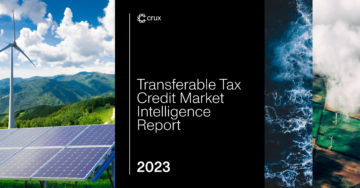
As companies seek to align their business practices with sustainability goals, chief financial officers are uniquely positioned to facilitate that transformation.
CFOs are accustomed to synthesizing data across organizations to analyze and report on business activities and risks for myriad stakeholders. Their teams will play a larger role in ESG reporting, especially delivering on regulations such as the European Union’s Corporate Sustainability Reporting Directive, which requires companies to disclose sustainability risks and what they’re doing to address them — or their rationale for choosing not to do so.
Finance teams will also be integral for developing climate transition plans that demonstrate how their company plans to move to net-zero business models, especially how they plan to finance those changes. Banks such as Barclays and HSBC, for example, have stopped funding certain fossil fuel projects and are requiring more information about transition plans from energy-sector clients.
Here are three other ways CFOs can make a big impact on sustainability performance, at little to no additional cost to their organization.
Use treasury funds to finance the net-zero transition
Non-financial corporations held roughly $6.9 trillion in cash and liquid securities on their balance sheets as of November, according to Barclay’s. Every dollar a company holds at a bank has an impact on the climate — positive or negative. That’s because when a company deposits its cash at a bank, the bank then uses that cash to make loans to other companies, including fossil fuel companies.
In one example, Meta had almost $48 billion in cash and investments on its balance sheet in 2021. Using what they say are conservative measures, three environmental groups estimated Meta’s “financed emissions” — those generated from its investment and lending activities — at 4,543 kilotons of carbon dioxide equivalent. That was 12 percent more than Meta’s reported emissions for 2020.
Deposits don’t need to be a source of negative sustainability impact. Unilever and L’Oréal have both worked with BNP Paribas to ensure their deposits are only used for financing energy transition activities or projects that support United Nations Sustainable Development Goals.
HSBC, Citi and BMO have also launched offerings that let corporate clients put excess cash towards financing projects such as renewable energy or affordable housing. Clients can receive better terms on their deposits if they meet predetermined sustainability targets.
Refresh retirement plans
Financed emissions associated with employer-run retirement programs are not typically measured in companies’ carbon footprint reporting. Upcoming updates to the widely used accounting and reporting standard, the Greenhouse Gas Protocol, could have a dramatic effect on what’s reported. As of August 2022, Mercer found that financed emissions from a company’s 401(k) plan are on average 33 times greater than its direct emissions.
Employer-based “defined contribution” retirement programs, including 401(k)s, held $9.9 trillion as of September. With $6.9 trillion of that invested in mutual funds, these plans are a critical source of capital for many corporations. That means companies that offer employee retirement plans wield a significant lever — they can push to put that money into sustainable finance activities.
One way employers can do this is by selecting sustainable funds that employees can choose within their 401(k). Examples include the Green Century Equity Fund, which uses a negative screen to prevent investments in producers of weapons, tobacco, oil and coal among others; and the Sphere 500 Climate Fund, which avoids investing in fossil fuel companies and votes the shares it holds in favor of climate action.
Invest insurance premiums sustainably
Insurers are big players in capital markets because they receive premiums upfront when they sell an insurance policy and then invest that money until they need to pay out a claim.
In 2019, insurers held more than half a trillion dollars in fossil fuels investments. Premiums for the Planet is a membership organization trying to change that calculus.
When a company joins Premiums for the Planet, its existing insurance coverage is moved to brokers that use the collective spend and influence of Premiums for the Planet members to arrange equal or better coverage from carriers that are “climate-conscious,” meaning they don’t serve projects that expand fossil fuel activities.
Existing members include bag and accessory maker Peak Designs, sunglasses maker Sunski and snowboarding gear maker Burton. As more companies join Premiums for the Planet, their collective bargaining power will grow. The goal is to give Premiums for the Planet more leverage with the insurers issuing the group’s policies, requiring them to invest the premiums in climate transition projects and discouraging them from financing and insuring the expansion of the fossil fuel industry.
In a testimonial, Peak Design CFO David Anhalt described the decision to join premiums for the Planet as a “no-brainer” and validated the organization’s claim that choosing this path doesn’t bring additional costs to the corporate insuree.
- SEO Powered Content & PR Distribution. Get Amplified Today.
- PlatoData.Network Vertical Generative Ai. Empower Yourself. Access Here.
- PlatoAiStream. Web3 Intelligence. Knowledge Amplified. Access Here.
- PlatoESG. Carbon, CleanTech, Energy, Environment, Solar, Waste Management. Access Here.
- PlatoHealth. Biotech and Clinical Trials Intelligence. Access Here.
- Source: https://www.greenbiz.com/article/3-finance-strategies-help-corporate-climate-goals
- :has
- :is
- :not
- 2019
- 2020
- 2021
- 2022
- 33
- 4
- 5
- 500
- 7
- 9
- a
- About
- accessory
- Accounting
- across
- Action
- activities
- Additional
- address
- affordable
- affordable housing
- align
- almost
- also
- among
- an
- and
- ARE
- AS
- associated
- At
- AUGUST
- average
- avoids
- bag
- Balance
- Balance Sheet
- balance sheets
- Bank
- Banks
- Barclays
- BE
- because
- Better
- Big
- Billion
- bnp paribas
- both
- bring
- brokers
- business
- business models
- business practices
- by
- CAN
- capital
- Capital Markets
- carbon
- carbon dioxide
- carbon footprint
- carriers
- Cash
- Century
- certain
- cfo
- CFOs
- change
- Changes
- chief
- Choose
- choosing
- Citigroup
- claim
- clients
- Climate
- climate action
- Coal
- Collective
- Companies
- company
- conservative
- Corporate
- Corporations
- Cost
- Costs
- could
- coverage
- critical
- data
- David
- decision
- delivering
- demonstrate
- deposits
- described
- Design
- designs
- developing
- Development
- direct
- Disclose
- do
- Doesn’t
- doing
- Dollar
- dollars
- Dont
- dramatic
- effect
- Emissions
- Employee
- employees
- employers
- energy
- ensure
- environmental
- equal
- equity
- Equivalent
- ESG
- especially
- estimated
- Ether (ETH)
- European
- Every
- example
- examples
- excess
- existing
- Expand
- expansion
- facilitate
- favor
- finance
- financed
- financial
- financing
- Footprint
- For
- Forbes
- fossil
- Fossil fuel
- fossil fuels
- found
- Free
- from
- FT
- Fuel
- fuels
- funds
- GAS
- Gear
- generated
- Give
- goal
- Goals
- greater
- Green
- Green Finance
- Group’s
- Grow
- had
- Half
- Have
- Held
- help
- holds
- housing
- How
- HSBC
- HTML
- HTTPS
- if
- Impact
- in
- include
- Including
- industry
- influence
- information
- insurance
- insurers
- integral
- into
- Invest
- invested
- investing
- investment
- Investments
- issues
- issuing
- IT
- ITS
- join
- Joins
- larger
- launched
- lending
- let
- lever
- Leverage
- Liquid
- little
- Loans
- make
- maker
- many
- Markets
- meaning
- means
- measured
- measures
- Meet
- Members
- membership
- Mercer
- Meta
- models
- money
- more
- move
- moved
- mutual
- mutual funds
- myriad
- Nations
- Need
- negative
- net-zero
- news
- Newsletter
- no
- node
- November
- of
- offer
- Offerings
- officers
- Oil
- on
- ONE
- only
- or
- organization
- organizations
- Other
- Others
- our
- out
- path
- Pay
- Peak
- percent
- performance
- plan
- planet
- plans
- plato
- Plato Data Intelligence
- PlatoData
- Play
- players
- policies
- policy
- positioned
- positive
- power
- practices
- prevent
- PRNewswire
- Producers
- Programs
- projects
- Push
- put
- rationale
- receive
- regulations
- Renewable
- renewable energy
- Reported
- Reporting
- requires
- retirement
- Reuters
- risks
- Role
- roughly
- say
- Screen
- Securities
- Seek
- selecting
- sell
- September
- serve
- Shares
- sheet
- sheets
- significant
- So
- Source
- spend
- stakeholders
- standard
- strategies
- such
- support
- Sustainability
- sustainable
- Sustainable Development
- targets
- teams
- terms
- than
- that
- The
- their
- Them
- then
- These
- they
- this
- those
- three
- times
- to
- tobacco
- towards
- Transformation
- transition
- treasury
- Trillion
- trying
- typically
- uniquely
- United
- united nations
- until
- us
- use
- used
- uses
- using
- validated
- votes
- was
- Way..
- ways
- Weapons
- weekly
- What
- when
- which
- widely
- wield
- will
- with
- within
- worked
- zephyrnet








